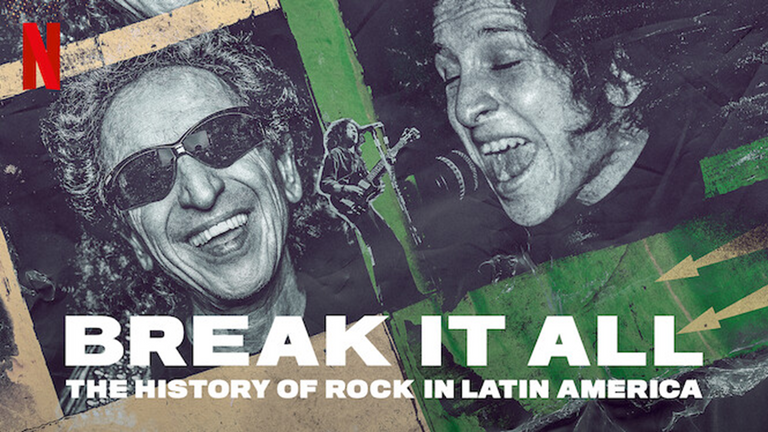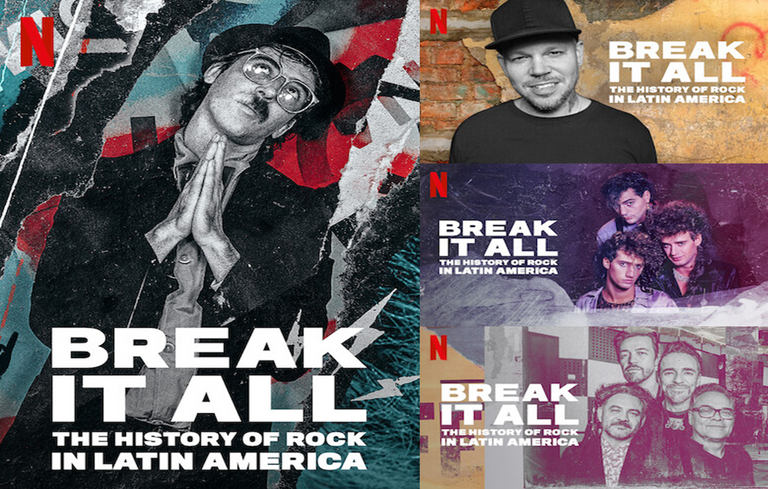Documentary review: "BREAK IT ALL: The History of Rock in Latin America", by bonzopoe

Source
The Netflix production, "BREAK IT ALL: The History of Rock in Latin America", is a docuseries, that is, a documentary series, in this case made up of 6 episodes that tries to portray 50 years of rock history in Latin America .
The series was created by Nicolás Entel, directed by Picky Talarico, and produced by Gustavo Santaolalla. The 3 recognized each in their field for their own merits, in particular Santaolalla who has become almost iconic in recent years for his foray into video game and movie soundtracks, which has earned him multiple awards in both media, which adds to his already rich and long career as a musician and producer.

Source
The series has its mistakes and its successes, and being such an ambitious project, this is not surprising. Among its successes is the manufacture of the series. Its production values are very good, and since it practically covers half a century of the musical history of the continent, it is to be recognized.
Another success is how it contextualizes the history of rock with the social, political and economic phenomena that Latin America has experienced in the second half of the 20th century and the first years of the 21st. The Chilean and Argentine dictatorships, the massacre of '68 in Tlatelolco, Mexico, the political crises in the southern cone, the electoral fraud in Mexico, the drug war in Colombia, the government's repression of rock and youth in the 70's, tremors and many other issues such as the emergence of MTV Latino and its impact, are there as a backdrop that gives meaning to the history of rock in the Latin part of the continent.

Source
The inclusion, and recognition, of key characters from the beginning of the history of rock in Latin America, who are sometimes ignored and/or underestimated, is also a success, as well as not just giving us data that we can find on Wikipedia, but to provide us with a view of history based on how those who lived it felt it, beyond the formalisms of the traditional interview.
Showing the generational and territorial relations between the artists is also a success. Find out how despite distances and age differences, and even musical postures, there is sincere recognition, respect and admiration that like a spider web unites the entire Latin American rock scene, and even Spain.

Source
But as many media have already pointed out in their criticism, there are also errors, probably due to budget issues, time, availability of those who wanted to be included, or even nepotism, as some suggest. Beyond the why, there are things that, for those of us familiar with the subject, are inevitably obvious.
The first thing that draws attention is how the series focuses on two poles: Argentina and Mexico, which to a certain extent is understandable, given their relevance as historical pivots of the movement, but this generates a quite noticeable imbalance with the weight and importance that is given to the treatment of the rest of the continent. And although Chile, Colombia and Uruguay are also discussed, it is not explored in the same way, limiting itself to certain artists, periods, or specific events.

Source
Very important representatives of rock from each country are not included, or are mentioned in a very superficial to brief way. In the case of Mexico, for example, the weight and importance of bands such as El TRI, Caifanes and Fobia are not recognized, although they are mentioned and appear in the series, and that is to mention just a few.
It is also noteworthy that there are some musicians who appear in the series, but whose bands are not mentioned even once, such as the mythical Chac Mool from Mexico, or Los Amigos Invisibles from Venezuela. When talking about Uruguay, the Cuarteto de Nos is never mentioned, but nevertheless one of its songs is used during an episode, and there are many such cases throughout the series.

Source
Finally we have the case of women in the history of rock, who although they are included, and are given their place to a certain extent at the end of the series, feel absent in much of it, and although it is true that proportionally speaking until a few decades ago, the rock scene was predominantly male territory. There are very important women who were ignored, such as Cecilia Toussaint or Kenny, from Kenny y los Eléctricos, who are iconic in the case of Mexico.
In general terms, the series is good, highly recommended, and something that is appreciated in these times when rock is in the doldrums and those of us who carry it in our DNA hope that it will soon return to the forefront, probably at the hands of women, as the series itself points out.
In these times of so many streaming and content platforms, whether you are a connoisseur or a neophyte in the matter, the series presents you with a sample of the great musical and cultural wealth of this beautiful, but complex continent, in which many of us had to live. Thanks for reading and until next time.
©bonzopoe, 2022.


Thank you very much for reading this post and dedicating a moment of your time. Until next time and remember to leave a comment.

0
0
0.000
0 comments